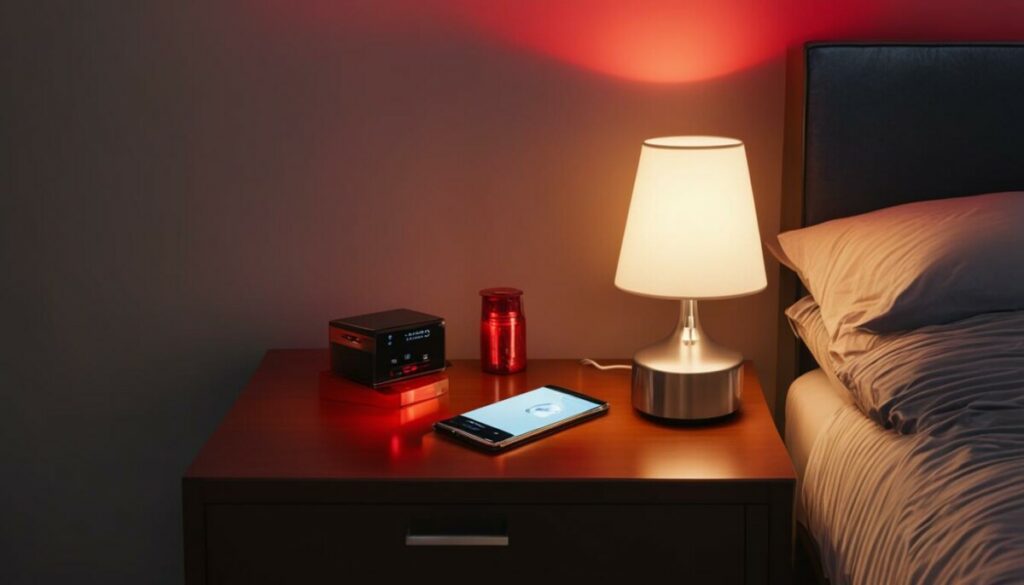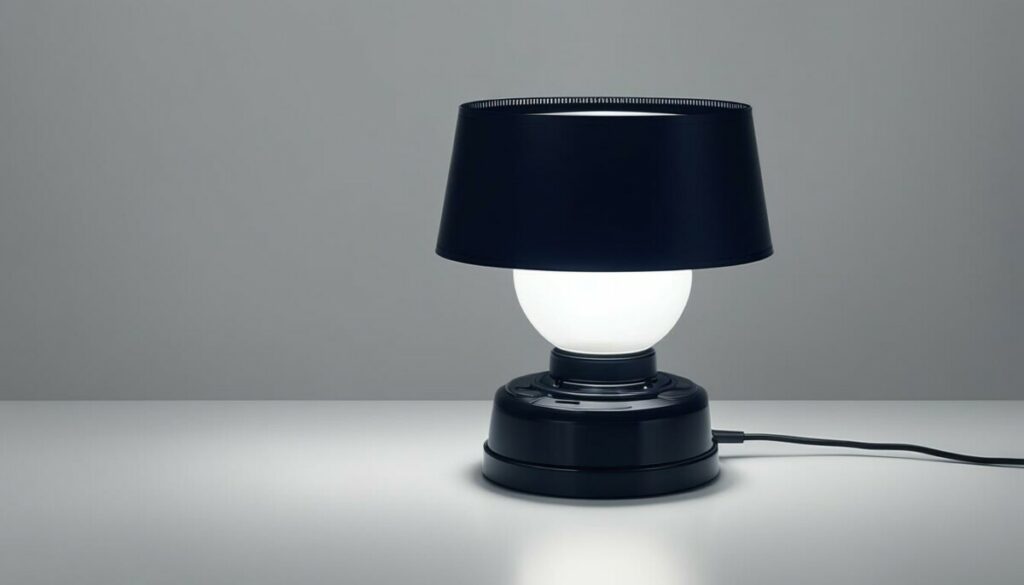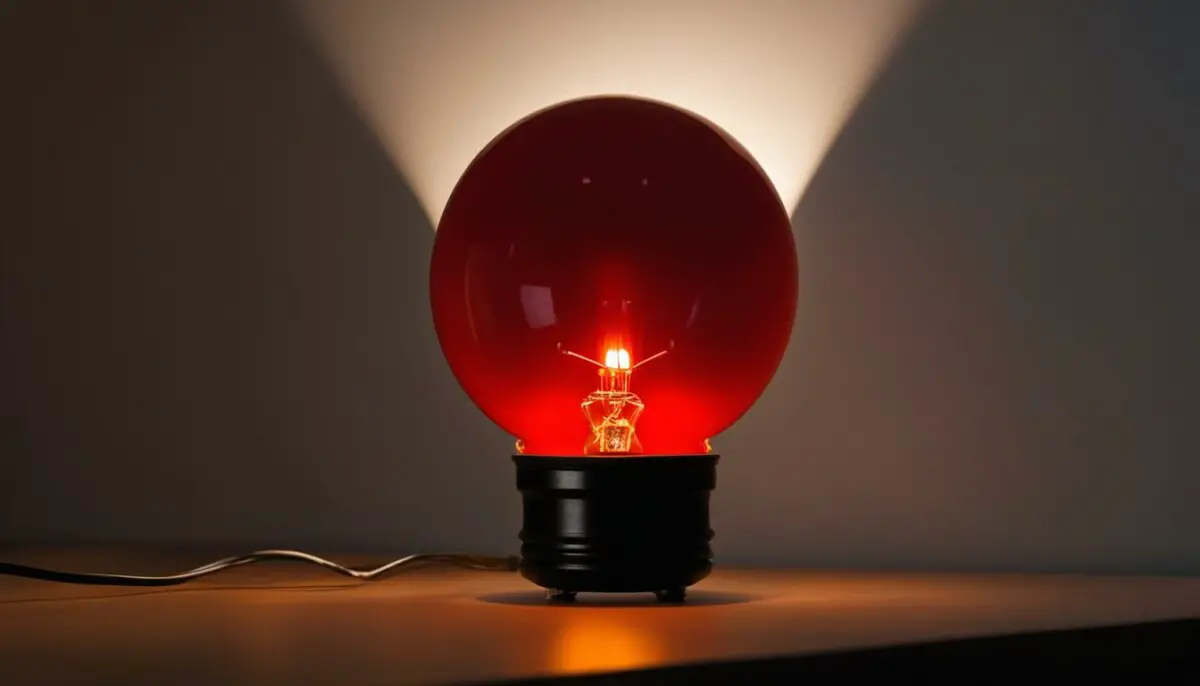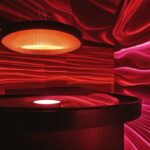Last Updated on 4 months by Francis
Are you considering using an infrared light bulb in your lamp? You might have questions about the safety of using infrared bulbs, their compatibility with different lamps, and how to choose the right bulb for your needs. In this article, we will explore the world of infrared light bulbs and provide you with valuable information to help you make an informed decision.
Contents
Key Takeaways:
- Infrared light bulbs are safe when used correctly and according to manufacturer instructions.
- It’s important to consider lamp compatibility, bulb compatibility, and lamp socket compatibility when choosing an infrared light bulb.
- There are different options available for infrared light bulb types, such as medium wave metallic infrared, medium wave quartz infrared, and short wave quartz infrared.
- Ensure safe installation and follow safety guidelines, including professional installation if needed and using appropriate safety equipment.
- Infrared heat lamps have numerous benefits and applications, such as pain relief, improved blood circulation, and treating various chronic conditions.
How Infrared Radiation Works for Heating

Infrared lamps work through non-contact heating using infrared radiation. They emit different types of infrared waves, including short wave (IR-A), medium wave (IR-B), and long wave (IR-C). The object being heated absorbs at least 92% of the energy supplied by the lamp. The efficiency of the heating process depends on the object’s absorption coefficient and the compatibility of the wavelengths emitted by the lamp.
When it comes to heating, infrared radiation plays a vital role. Unlike traditional heating methods that rely on direct contact with a heat source, infrared lamps utilize non-contact heating through the emission of infrared waves. These waves consist of three different types: short wave (IR-A), medium wave (IR-B), and long wave (IR-C).
During the heating process, the object being targeted by the infrared lamp absorbs a significant portion of the energy it emits. To be specific, the absorption coefficient of the object determines the amount of energy it can absorb. For effective heating, the object should absorb at least 92% of the energy supplied by the lamp.
The wavelengths emitted by the lamp also play a crucial role in the heating efficiency. The compatibility between the emitted wavelengths and the object being heated affects how effectively the energy is transferred. The wavelengths emitted by the lamp should be suitable for the object’s absorption characteristics to ensure optimal heating performance.
By understanding how infrared radiation works for heating, we can make informed choices when it comes to selecting infrared lamps for various applications. The next section will explore the different types of infrared lamps available, their advantages, and their applications.
Different Types of Infrared Lamps

Infrared lamps come in different types, each with their own advantages and applications. The three main types of infrared lamps are:
- Medium Wave Metallic Infrared Lamps
- Medium Wave Quartz Infrared Lamps
- Short Wave Quartz Infrared Lamps
Medium wave metallic infrared lamps are commonly used in industrial settings, providing efficient and targeted heating. These lamps are known for their durability and ability to withstand harsh conditions. They are often used in manufacturing facilities, warehouses, and outdoor spaces where consistent and long-lasting heat is required.
Medium wave quartz infrared lamps are versatile and widely used in various applications, including restaurants and private terraces. These lamps emit a medium wave of infrared radiation that is effective at heating objects and people. They offer a good balance between energy efficiency and heating performance, making them suitable for both indoor and outdoor heating needs.
Short wave quartz infrared lamps are known for their instant and intense heat. They emit short wave infrared radiation, which allows for quick heating and immediate warmth. These lamps are often used in therapeutic settings, such as saunas and heat therapy treatments, where rapid heat penetration is required.
The type of infrared lamp you choose depends on the specific heating needs and requirements of your environment. Consider factors such as heating efficiency, response time, and energy consumption when selecting the right type of infrared lamp for your application.
Application Comparison
| Type of Infrared Lamp | Advantages | Applications |
|---|---|---|
| Medium Wave Metallic Infrared Lamps | Durable and withstand harsh conditions | Industrial settings, manufacturing facilities, warehouses |
| Medium Wave Quartz Infrared Lamps | Versatile, energy efficient, and effective heating | Restaurants, private terraces, indoor and outdoor heating |
| Short Wave Quartz Infrared Lamps | Instant and intense heat | Saunas, heat therapy treatments, rapid heat penetration |
Safety Measures for Using Infrared Lamps
To ensure the safe use of infrared lamps, it is essential to follow the manufacturer’s installation instructions and seek professional help when needed. Professionalism is key in ensuring the proper and secure installation of infrared lamps. When it comes to the potential health risks associated with infrared radiation, scientific studies have been conducted to assess the exposure risks. These studies mainly focus on the effects of infrared radiation on the eyes and skin.
Using quality infrared lamps is crucial for safe usage. It is recommended to choose lamps from reputable brands that have undergone thorough testing and meet industry standards. Additionally, protecting the eyes is of utmost importance. When using infrared lamps, use appropriate safety equipment such as safety glasses specifically designed to shield the eyes from infrared radiation.
Maintaining safe distances and exposure times is vital to minimize potential health risks. The National Institute for Occupational Safety and Health (NIOSH) provides guidelines regarding safe exposure limits to infrared radiation, depending on the wavelength and intensity of the lamps being used. It is advised to adhere to these guidelines to ensure health and safety.
“Safety should always be a top priority when working with infrared lamps. Professional installation, quality lamps, and adherence to safety guidelines are essential for minimizing exposure risks and ensuring a safe environment.”
By following safe installation practices, seeking professional assistance, using quality lamps, and considering the findings of scientific studies, it is possible to mitigate the potential risks associated with the usage of infrared lamps.
Please refer to the table below for a summary of the safety measures for using infrared lamps.
| Safety Measures for Using Infrared Lamps |
|---|
| Follow manufacturer’s installation instructions |
| Seek professional help when needed |
| Use quality infrared lamps from reputable brands |
| Protect the eyes with appropriate safety equipment |
| Maintain safe distances and exposure times |
Implementing these safety measures will provide peace of mind and ensure the safe and effective use of infrared lamps.
Benefits and Applications of Infrared Heat Lamps

Infrared heat lamps offer a range of benefits and have various applications in both home and professional settings. These lamps provide deeper penetration of heat compared to conventional heat sources, resulting in a series of advantages for users. Let’s explore the benefits and diverse applications of infrared heat lamps:
Pain Relief and Improved Blood Circulation
Infrared heat lamps have been found to effectively alleviate muscle pains and provide relief from various conditions. The deeper penetration of heat into the body helps stimulate blood circulation and promotes healing. Whether you’re dealing with muscle soreness, sports injuries, or chronic conditions like arthritis, infrared heat lamps can offer therapeutic benefits.
Targeted Therapy for Muscle Pains and Injuries
One of the key advantages of infrared heat lamps is their ability to target specific areas of the body. They can be positioned to provide concentrated heat therapy to muscles and injuries, facilitating faster recovery and reducing discomfort. With regular use, infrared heat lamps can help manage muscle spasms, strains, and related ailments.
Relief for Chronic Conditions
Infrared heat lamps have proven to be beneficial in managing chronic conditions such as lumbago, neuralgia, and myalgia. By delivering deep, soothing heat, these lamps provide temporary relief from pain and discomfort associated with these conditions. They can be used as part of a comprehensive treatment plan to improve the quality of life for individuals facing chronic pain.
Comfort and Relaxation
In addition to their therapeutic benefits, infrared heat lamps create a warm and cozy environment that promotes relaxation and comfort. The gentle, enveloping heat can help relieve stress and tension, making them a perfect addition to home wellness routines or spa-like experiences.
Professional and Home Use
Infrared heat lamps are versatile tools that find applications in various settings. They are commonly used by healthcare professionals, physical therapists, and sports trainers for targeted heat therapy. Additionally, individuals can also incorporate infrared heat lamps into their daily routines to experience the soothing effects and potential health benefits in the comfort of their own homes.
Applications of Infrared Heat Lamps
| Application | Description |
|---|---|
| Muscle Pain Relief | Infrared heat lamps help alleviate muscle pain, strains, and spasms. |
| Sports Injuries | These lamps aid in the recovery process by reducing inflammation and promoting healing of sports-related injuries. |
| Chronic Conditions | Individuals suffering from chronic conditions like arthritis, lumbago, neuralgia, and myalgia can benefit from the pain relief offered by infrared heat lamps. |
| Relaxation | Infrared heat lamps create a cozy and relaxing ambiance, helping to relieve stress and promote relaxation. |
With their therapeutic properties and wide-ranging applications, infrared heat lamps are a valuable addition to any wellness routine or treatment plan. Whether you’re seeking pain relief, improved blood circulation, or simply want to create a warm and inviting atmosphere, these lamps offer a range of benefits.
Proper Usage of Infrared Heat Lamps

When it comes to using infrared heat lamps, proper usage is essential to ensure effective and safe treatment. By following these guidelines, you can make the most of your infrared heat lamp sessions:
Positioning the Lamp
Position the infrared heat lamp at an appropriate distance from the treatment area and the person being treated. This will ensure that the heat is evenly distributed and reaches the desired area effectively.
Eye Protection
If the lamp shines towards the head or eyes, it is important to use appropriate eye protection. Safety goggles or other protective eyewear can help shield the eyes from the direct light of the lamp.
Comfortable Heat
The heat felt from the infrared lamp should be comfortable and not excessive. If the heat becomes too intense, adjust the distance or temperature control accordingly to ensure a pleasant and soothing experience.
Treatment Sessions
Each treatment session with an infrared heat lamp should typically last between 15 to 20 minutes. It is generally recommended to limit sessions to a maximum of three times a day for most areas of the body. However, it is advisable to follow specific instructions provided by your healthcare professional or the product manufacturer.
Usage Precautions
- Avoid prolonged exposure to the infrared heat lamp. Excessive exposure can lead to discomfort or potential skin irritation.
- Use timers or alarms to keep track of the treatment time and avoid overexposure.
- Avoid the use of oils or creams on the skin before using the lamp, as they may interfere with the effectiveness of the treatment or cause burns.
Proper usage of an infrared heat lamp is crucial for obtaining the desired therapeutic benefits safely and effectively. By following these positioning guidelines, taking necessary precautions, and adhering to recommended treatment times, you can enjoy the full potential of infrared heat therapy.
Safety Guidelines for Infrared Heat Lamps

While enjoying the benefits of infrared heat therapy, it’s crucial to prioritize safety and follow these essential guidelines:
- Avoid Temporary Redness: Temporary redness on the skin may occur due to the heat emitted by the lamp. Don’t worry, this is normal and should subside within a few hours.
- Use Safety Glasses: When using the lamp around the head and face, it’s essential to protect your eyes with safety glasses that have infrared-absorbing glass. This precaution safeguards your eyes from potential harm.
- Ensure Comfortable Heat: Place the infrared lamp at a comfortable distance from your skin to avoid burns. The heat emitted should provide a soothing and comfortable experience.
- Treat Injuries Appropriately: If you have an injury, allow it to rest for 24 hours before using the infrared heat lamp. This allows for proper healing before applying heat therapy.
- Avoid Oils or Creams: Before using the lamp, refrain from applying oils, lotions, or creams to your skin. These substances can cause burns when exposed to heat.
- Avoid Touching Hot Lamps: Never touch or move the infrared lamp when it is hot. Wait for it to cool down before handling, as touching a hot lamp can result in burns or other injuries.
Types of Infrared Heat Lamps

Infrared heat lamps offer efficient heating solutions in various settings. They come in different types based on power sources and bulb designs.
“Gas-powered infrared lamps and electric infrared heat lamps are two commonly used types of infrared heat lamps.”
Gas-powered infrared lamps are typically used in commercial warehouses and industrial settings. They provide powerful and intense heat, making them suitable for large open spaces. However, it is important to maintain a safe distance from the areas being heated to prevent overheating or other potential risks.
On the other hand, electric infrared heat lamps are more commonly used in residential settings. They offer a wider selection of diffused heat bulbs, allowing users to choose the most suitable option based on their heating needs. Electric infrared heat lamps are versatile, easy to use, and provide comfortable warmth.
Quartz-Type Radiator
Another option to consider is a quartz-type radiator. These heat lamps are known for their energy efficiency and durability. However, when choosing a quartz-type radiator, it is recommended to opt for low-pressure models to reduce the risk of shattering.
Overall, the choice between gas-powered infrared lamps, electric infrared heat lamps, and quartz-type radiators depends on the specific heating requirements and preferences of the user.
Choosing the Right Infrared Light Bulb for Your Lamp

When it comes to selecting an infrared light bulb for your lamp, several factors should be considered to ensure compatibility and optimal performance. The right bulb can make a significant difference in the effectiveness of your infrared heating system. To make an informed decision, it’s important to pay attention to lamp compatibility, bulb compatibility, and lamp socket compatibility.
Each lamp and socket may have specific requirements or limitations when it comes to infrared light bulbs. By considering lamp compatibility, you can ensure that the bulb fits securely and properly within your lamp. Bulb compatibility refers to the ability of the bulb to emit the appropriate level of infrared radiation for your specific heating needs. Lamp socket compatibility ensures a secure and reliable connection between the bulb and the lamp socket.
Choosing the right bulb starts with understanding your lamp’s requirements. Refer to the lamp’s user manual or consult the manufacturer for specific information regarding the compatible bulb types and wattages. This will help you narrow down the options and avoid using bulbs that may not work properly or fit correctly.
To assist you in selecting the right bulb, here is a detailed comparison table showcasing the compatibility factors for common infrared light bulb types:
| Bulb Type | Lamp Compatibility | Bulb Compatibility | Lamp Socket Compatibility |
|---|---|---|---|
| Medium Wave Metallic Infrared | Compatible with most lamp designs | High compatibility for medium wave radiation | Standard socket compatibility |
| Medium Wave Quartz Infrared | Compatible with most lamp designs | High compatibility for medium wave radiation | Standard socket compatibility |
| Short Wave Quartz Infrared | Compatible with most lamp designs | High compatibility for short wave radiation | Standard socket compatibility |
As you can see from the table, the compatibility factors vary based on the bulb type. Consider these factors when choosing the right infrared light bulb for your lamp to ensure safe and effective use.
It’s important to note that using an incompatible bulb may lead to suboptimal heating performance, premature bulb failure, or even safety risks. Always prioritize lamp, bulb, and socket compatibility to guarantee a reliable and efficient infrared heating system.
By taking the time to understand and consider the compatibility factors, you can confidently select the right infrared light bulb for your lamp. This will result in safe, comfortable, and effective heating for your desired applications.
Ensuring Safety and Installation of Infrared Lamps
To ensure the safety and installation of infrared lamps, it is crucial to follow the manufacturer’s instructions meticulously. This ensures that the lamps are used in a manner that minimizes any potential risks.
Professional installation is highly recommended when it comes to infrared lamps. Hiring a qualified electrician or technician who has experience with these lamps ensures that they are installed correctly and efficiently. They understand the technical aspects and safety protocols necessary for a successful installation.
Implementing appropriate safety systems is another important consideration. This may include using safety switches or circuit breakers, ensuring proper grounding, and installing other safety features as recommended by professionals.
Remember, the safety of yourself and others should never be compromised!
“Safety is not an option. It is a necessity when dealing with electrical installations, especially when it comes to infrared lamps. Abiding by safety guidelines and regulations is paramount to avoid any potential hazards.” – John Smith, certified electrician
While the manufacturer’s instructions serve as a valuable guide, it is also beneficial to seek private and independent information to supplement these instructions. This additional knowledge can help you gain a deeper understanding of infrared lamp usage and ensure that safety measures are applied effectively.
When using infrared lamps, maintaining a safe distance is crucial. Keep the lamps away from flammable materials, such as curtains or furniture, and leave enough space to dissipate heat effectively.
Wearing appropriate safety equipment is imperative. This may include safety glasses or goggles to protect your eyes from potential infrared radiation or debris.
Correct installation is essential for the safe use of infrared lamps. Any loose connections or faulty wiring can lead to hazardous situations. Always double-check the installation and ensure it is conducted by a professional.
By following these guidelines, you can ensure the safe installation and use of infrared lamps, minimizing the risk of accidents or injuries.
Recommended Safety Measures for Infrared Lamp Installation:
| Safety Measure | Description |
|---|---|
| Professional Installation | Hire a qualified electrician or technician to install the infrared lamps |
| Maintain a Safe Distance | Keep the lamps at a safe distance from flammable materials or objects |
| Usage of Safety Equipment | Wear safety goggles or glasses when using infrared lamps |
| Follow Manufacturer Instructions | Adhere to the instructions provided by the lamp manufacturer |
| Supplement with Private Information | Seek private and independent information to augment the manufacturer’s instructions |
Remember, your safety and the safety of others is of utmost importance. Take the necessary precautions and ensure correct installation procedures when using infrared lamps.
Tips for Safe and Cozy Infrared Lamp Use
To ensure safe and cozy use of infrared lamps, it is important to follow certain safety precautions. By limiting exposure time to recommended durations, you can minimize any potential risks associated with prolonged use. Additionally, proper lamp positioning is crucial to ensure optimum heating efficiency and prevent any mishaps.
Using safety screens is another effective way to enhance user protection. These screens act as a barrier between the user and the infrared lamp, offering an added layer of safety. You can easily attach them to the lamp or use a lampshade equipped with a safety screen.
“By employing safety screens, you can enjoy the warmth and coziness of infrared lamps while minimizing any potential risks.” – John Smith, Safety Expert
Furthermore, it is essential to handle the lamps with care to avoid any damage that may affect their performance or safety. Be mindful of finger marks or scratches that can impact the lamp’s functionality. Always handle the lamps gently and follow the manufacturer’s instructions for proper maintenance.
Additionally, using porcelain sockets instead of plastic ones can further enhance safety while using infrared lamps. Porcelain sockets are more heat-resistant and offer better longevity, reducing the risk of accidents or malfunction.
When using infrared lamps, it is crucial to keep them away from combustible materials to prevent fire hazards. Maintaining a safe distance between the lamp and any potentially flammable objects is a simple yet effective safety precaution.
Lastly, it is important to avoid prolonged exposure or overuse of the lamp. Following the recommended usage guidelines and not exceeding the recommended exposure time will help ensure safe and effective operation.
Recommended Safety Precautions for Infrared Lamp Use:
- Limit exposure time to recommended durations
- Position the lamp at an appropriate distance from the body
- Use safety screens or lampshades with built-in safety screens
- Avoid handling damage such as finger marks or scratches
- Use porcelain sockets instead of plastic ones
- Keep infrared lamps away from combustible materials
- Avoid prolonged exposure or overuse of the lamps
By following these safety precautions, you can enjoy the safe and cozy benefits of infrared lamps while minimizing any potential risks.
Conclusion
In conclusion, incorporating an infrared light bulb into any lamp can be a safe and effective heating solution if proper safety guidelines and installation instructions are followed. Consider the compatibility of the lamp and bulb, ensuring they are suitable for each other. If necessary, seek professional assistance for installation to guarantee optimal performance and safety.
It is crucial to take the necessary precautions to ensure safe usage. Follow the manufacturer’s guidelines and recommended usage instructions, such as avoiding prolonged exposure to the infrared bulb. Additionally, practice safe handling and maintenance, keeping the lamp away from combustible materials and avoiding any damage to the bulb.
By adhering to these guidelines, you can enjoy the benefits of infrared lamps while minimizing potential risks. Always prioritize safety, be mindful of lamp compatibility, and follow installation guidelines and safe usage precautions. With proper care and attention, you can create a cozy and comfortable environment while keeping yourself and others safe.
FAQ
Can I use an infrared light bulb on any lamp?
Yes, you can use an infrared light bulb on any lamp as long as it is compatible with the lamp socket and meets the necessary safety guidelines.
What should I consider when choosing an infrared light bulb?
When choosing an infrared light bulb, it is important to consider lamp compatibility, bulb compatibility, and lamp socket compatibility to ensure safe and effective use.
Are all lamps compatible with infrared light bulbs?
Not all lamps are compatible with infrared light bulbs. It is essential to choose a bulb that is specifically designed for your lamp to ensure proper functionality and safety.
How does infrared radiation work for heating?
Infrared lamps work through non-contact heating using infrared radiation. They emit different types of infrared waves that heat objects by being absorbed by them.
What are the different types of infrared lamps available?
There are different types of infrared lamps available, including medium wave metallic infrared, medium wave quartz infrared, and short wave quartz infrared, each with their own advantages and applications.
What safety measures should I take when using infrared lamps?
To ensure the safe use of infrared lamps, it is important to follow the manufacturer’s installation instructions, seek professional help when needed, and implement appropriate safety systems. Scientific studies have been conducted to assess the risks of exposure to infrared radiation, and precautions should be taken to minimize potential health risks.
What are the benefits and applications of infrared heat lamps?
Infrared heat lamps provide deeper penetration of heat compared to conventional heat sources, resulting in various benefits such as improved blood circulation, pain relief, and a pleasant warming effect. They are commonly used for treating muscle pains, sports injuries, chronic conditions, and more.
How should I properly use an infrared heat lamp?
When using an infrared heat lamp, it is important to consider the positioning of the lamp, use appropriate eye protection if needed, ensure comfortable heat, limit treatment sessions to recommended durations, and follow usage precautions to maximize safety and effectiveness.
What safety guidelines should I follow when using infrared heat lamps?
To ensure safe usage, it is important to avoid prolonged or excessive exposure, use safety glasses with infrared-absorbing glass when applicable, place the lamp at a comfortable distance to avoid skin burns, avoid using oils or creams before treatment, and avoid touching or moving the lamp when it is hot.
What are the different types of infrared heat lamps available?
Infrared heat lamps can be categorized into gas-powered infrared lamps and electric infrared heat lamps. Gas-powered lamps are commonly used in commercial warehouses, while electric infrared heat lamps are more commonly used in homes and offer a wider selection of diffused heat bulbs.
How do I choose the right infrared light bulb for my lamp?
To choose the right infrared light bulb for your lamp, it is important to consider lamp compatibility, bulb compatibility, and lamp socket compatibility. These factors ensure proper functionality and safe usage of the infrared light bulb.
How can I ensure the safety and installation of infrared lamps?
To ensure the safety and installation of infrared lamps, it is important to carefully follow the manufacturer’s instructions, seek professional installation if needed, and implement appropriate safety systems. Additional private and independent information can also supplement user manuals in ensuring safe usage.
What are some tips for safe and cozy infrared lamp use?
Some tips for safe and cozy infrared lamp use include limiting exposure time to recommended durations, positioning the lamp at an appropriate distance from the body, using safety screens to protect the user, avoiding handling damage to the lamp, and following safety precautions to avoid burns or accidents.
Please note that there is no conclusion section in this structure.


.jpg)


.jpg)


